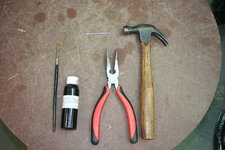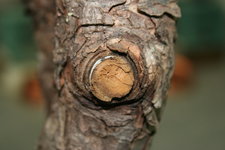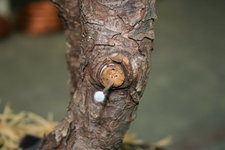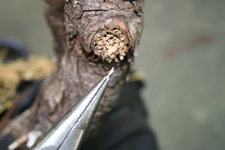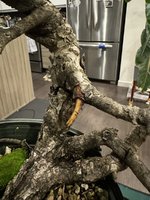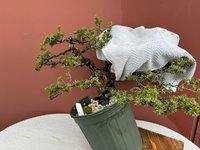You are using an out of date browser. It may not display this or other websites correctly.
You should upgrade or use an alternative browser.
You should upgrade or use an alternative browser.
The Hemlock (Tsuga) Discussion THREAD.
- Thread starter ghues
- Start date
River's Edge
Imperial Masterpiece
Typical Hemlock response, they resist wiring and require repeated application. I have found the best routine is to reapply the wire immediately. Often with just placing the wire either counter to the previous application or change the spacing. When they are allowed to rest between wiring it is almost the same as starting over again. One other technique that aids in improving the progress is the method used during application of the wire. If the branch is moved back and forth a bit to create micro breaks before setting in position the branch heal the micro breaks and will stay in position better. The healing of the micro breaks creates stronger structure faster than the branch will put on additional thickness to hold the final position. Just a couple of techniques to pass on.My spindly little Eastern hemlock is chugging along. I just took some wire off that was starting to cut in and the branches on the right sprang right back up, so I need to wire those down again.
View attachment 373324
0soyoung
Imperial Masterpiece
More specifically, it ruptures some cambium cells which induced the production of ethylene. Ethylene affects more rapid radial (thickening) growth. A branch 'setting' is a 'tug-of-war' of the old versus the new. Your wiggling cases and enhancement of the new wood (which, of course, grows in accordance with the position it is in).If the branch is moved back and forth a bit to create micro breaks before setting in position the branch heal the micro breaks and will stay in position better. The healing of the micro breaks creates stronger structure faster than the branch will put on additional thickness to hold the final position. Just a couple of techniques to pass on.
Letting wire 'bite in' interrupts the PAT flow, leading to an accumulation of auxin above the wire. Too much auxin affects ethylene production --> enhanced radial growth. The tug-of-war gets won more quickly, hence the magic of wire scarring, the magic of letting wire bite in to make fat trunks.
River's Edge
Imperial Masterpiece
" I think I nailed it!"
Yamadori often arrive with older heavier branches that require removal or jin. It is good to have alternatives for treatment Thought I would share a method I prefer for dealing with the result of removing larger branches. This is an alternative to healing the scar and still leaving a somewhat natural appearance. Trees in nature often have hollows or recesses where branches once were.
To help the elderly remember this approach I am use the tag line. " I think I Nailed It"
The inspiration for this concept is long forgotten, I might have even made it up or stolen it from someone else.
Tools required.
Hammer, nail, needle nose pliers, india ink, small paint brush.
Process.
Step One - hammer nail into the branch stub, helps if stub is left minimum 1/2 inch away from trunk.
Step Two- as possible grab splinters with needle nose and pull/twist out.
Repeat step one and two as often as required, the goal is to recess the branch area without damaging the surrounding bark and collar.
final step allow nature to age the remaining area, or as I prefer touch up with a bit of diluted India ink. It turn grey quite nicely in the sun.
So some pictures to help illustrate my ramblings. The full size image shows a much larger example that was done several years ago!
Tools required
Yamadori often arrive with older heavier branches that require removal or jin. It is good to have alternatives for treatment Thought I would share a method I prefer for dealing with the result of removing larger branches. This is an alternative to healing the scar and still leaving a somewhat natural appearance. Trees in nature often have hollows or recesses where branches once were.
To help the elderly remember this approach I am use the tag line. " I think I Nailed It"
The inspiration for this concept is long forgotten, I might have even made it up or stolen it from someone else.
Tools required.
Hammer, nail, needle nose pliers, india ink, small paint brush.
Process.
Step One - hammer nail into the branch stub, helps if stub is left minimum 1/2 inch away from trunk.
Step Two- as possible grab splinters with needle nose and pull/twist out.
Repeat step one and two as often as required, the goal is to recess the branch area without damaging the surrounding bark and collar.
final step allow nature to age the remaining area, or as I prefer touch up with a bit of diluted India ink. It turn grey quite nicely in the sun.
So some pictures to help illustrate my ramblings. The full size image shows a much larger example that was done several years ago!

Tools required
Attachments
pandacular
Masterpiece
Has anyone had success with airlayers? I have a T. mertensiana which I’ve really enjoyed, but it has an awkward conglomeration of branches. I figure if I can get a layer to take, I can two trees out of it! I saw @MrFancyPlants mention it. Did you have success with that layer?
the tree in question (poor picture, partially wired…been meaning to take some proper pics now that I’ve finished it)

a closeup of the weird branch conglomeration

I would layer off the first branch, which crosses behind the second. Actually, it seems unlikely that either stay in the final design, but the first branch is the one I need to cut first to really decide that.
This thread was a great read! Considering I bought this tree to practice wiring yamadori, I think I made a great pick, given Frank’s advice about the need for repeated wiring.
the tree in question (poor picture, partially wired…been meaning to take some proper pics now that I’ve finished it)

a closeup of the weird branch conglomeration

I would layer off the first branch, which crosses behind the second. Actually, it seems unlikely that either stay in the final design, but the first branch is the one I need to cut first to really decide that.
This thread was a great read! Considering I bought this tree to practice wiring yamadori, I think I made a great pick, given Frank’s advice about the need for repeated wiring.
Attachments
Hartinez
Masterpiece
I think if it were mine I’d remove one or even 2 of the branches from that awkward junction. It may not make the perfect image to start but will give you a better place to start in that area.Has anyone had success with airlayers? I have a T. mertensiana which I’ve really enjoyed, but it has an awkward conglomeration of branches. I figure if I can get a layer to take, I can two trees out of it! I saw @MrFancyPlants mention it. Did you have success with that layer?
the tree in question (poor picture, partially wired…been meaning to take some proper pics now that I’ve finished it)
View attachment 520818
a closeup of the weird branch conglomeration
View attachment 520820
I would layer off the first branch, which crosses behind the second. Actually, it seems unlikely that either stay in the final design, but the first branch is the one I need to cut first to really decide that.
This thread was a great read! Considering I bought this tree to practice wiring yamadori, I think I made a great pick, given Frank’s advice about the need for repeated wiring.
Will you circle where that grouping is, in the pic you have from a distance?
Edit - I see it. You have so much other great branching. Cleaning up that location can only benefit the image long term.
Last edited:
BobbyLane
Imperial Masterpiece
I thought the same thing.I think if it were mine I’d remove one or even 2 of the branches from that awkward junction. It may not make the perfect image to start but will give you a better place to start in that area.
Will you circle where that grouping is, in the pic you have from a distance?
Edit - I see it. You have so much other great branching. Cleaning up that location can only benefit the image long term.
River's Edge
Imperial Masterpiece
I would consider removing the two bottom left branches as well as modifying or removing the jin on the same side between the two lower branches. If the jin remains , I would shorten it to be pointing down not up. Too distracting for the rest of the design. My reasoning is as follows, the branches have no foliage near the trunk and are too thick to shorten believably with wired movement. They are also pretty close together creating a visual congestion of sorts.Has anyone had success with airlayers? I have a T. mertensiana which I’ve really enjoyed, but it has an awkward conglomeration of branches. I figure if I can get a layer to take, I can two trees out of it! I saw @MrFancyPlants mention it. Did you have success with that layer?
the tree in question (poor picture, partially wired…been meaning to take some proper pics now that I’ve finished it)
View attachment 520818
a closeup of the weird branch conglomeration
View attachment 520820
I would layer off the first branch, which crosses behind the second. Actually, it seems unlikely that either stay in the final design, but the first branch is the one I need to cut first to really decide that.
This thread was a great read! Considering I bought this tree to practice wiring yamadori, I think I made a great pick, given Frank’s advice about the need for repeated wiring.
I understand wiring those side branches up to try and fill in the design on the side with few branches. With the wiring try to maintain a similar movement in the branches overall. Gentle curves or more pronounced curves. A mixture of both takes away from the sense of unity in the overall form. I feel the bare portions will never change and always distract from the overall. Particularly with Hemlock foliage and the natural growth pattern it is difficult to hide the inner branch bareness.
Except for the apical leader I would begin to wire down the other branches to create downward movement beginning where the branches come off the main trunk. For this because you are using aluminum wire you may wish to combine wire on the branch and guy wires to pull down the branch. The natural growth of mountain hemlock has low sweeping branches. The upright movement that is currently wired in signifies a very young confer or deciduous trees natural growth pattern. The side shoots initially should be wired out flat to the sides of the branch, This way they will fill in and the natural upright growth habit will form pads.
It appears that there are some really nice small branches on the trunk that can be grown out and repositioned to the right side over the long term. they will develop faster and stay healthier if the larger ones on the lower right are removed. Remembering to prune more up top in order to keep the lower branching healthier and not shaded out!
Just a few thoughts with morning coffee. Sorry to interrupt.
Back to the original question. Not aware of Mountain hemlock being air-layered, nor have they been grafted to my knowledge.
pandacular
Masterpiece
your thoughts are always appreciated! I was planning to leave the two branches on in order to aid in root growth after repotting, as well as give s shot to an air layer. I agree that I don’t really see a place in the final design for those two branches, but the tree at the moment isn’t bursting with growth, so I figured more foliage is better for now. The jin you mentioned will be shortened at some point, but it’s currently doing duty as support for the giy wire that is keeping the two branches from touching. It’s also the elephants trunk.Just a few thoughts with morning coffee. Sorry to interrupt.
pandacular
Masterpiece
Some fresher pics, including a towel masking off some branch removals, and showing the left branches (i.e. the keepers) actually wired.


detail of the keepers from above


I must say, it is gratifying of my bonsai instincts that the plan of action all three of you describe is so close to the one I had in mind, as I respect the advice and trees of you all greatly.
Looking at the low branches closer, it’s less clear that either one is worth the time and bench space to air layer them. I suppose the question is now, should I leave the branches to aid in root growth after repotting in the spring? I believe this will be it’s first repot since collection, so i plan to leave 1/2 or 2/3 of the native soil in place, and put it back into some sort of development container.


detail of the keepers from above


I must say, it is gratifying of my bonsai instincts that the plan of action all three of you describe is so close to the one I had in mind, as I respect the advice and trees of you all greatly.
Looking at the low branches closer, it’s less clear that either one is worth the time and bench space to air layer them. I suppose the question is now, should I leave the branches to aid in root growth after repotting in the spring? I believe this will be it’s first repot since collection, so i plan to leave 1/2 or 2/3 of the native soil in place, and put it back into some sort of development container.
Attachments
BobbyLane
Imperial Masterpiece
Looks to me like it has better potential as a raft/clump style tree. With some angle changes, I'd have a look at bringing everything upright as trunks.
Funny enough Riversedge has some nice clumps to look at for inspo. The short stub of a base and branches all meeting at a similar point looks fit for clump form/candelabra.
Great video on manipulating branches into trunks
Funny enough Riversedge has some nice clumps to look at for inspo. The short stub of a base and branches all meeting at a similar point looks fit for clump form/candelabra.
Great video on manipulating branches into trunks
Last edited:
River's Edge
Imperial Masterpiece
Yes I would leave them if you plan to repot this spring, Actually with that amount of work I would delay the partial repot until mid to late august at the earliest. Typically I restrict myself to one major insult per year on the trees. That is a fairly aggressive pruning and wiring to recover from. Particularly if it is still in old soil and has not been acclimated to bonsai soil. If that were the case I would expect a stronger healthier rootball and then would be willing to progress more quickly! Mountain hemlock respond very well once they have adapted to Bonsai soil and have developed a proper rootball for Bonsai purposes.Some fresher pics, including a towel masking off some branch removals, and showing the left branches (i.e. the keepers) actually wired.
View attachment 520836
View attachment 520838
detail of the keepers from above
View attachment 520839
View attachment 520840
I must say, it is gratifying of my bonsai instincts that the plan of action all three of you describe is so close to the one I had in mind, as I respect the advice and trees of you all greatly.
Looking at the low branches closer, it’s less clear that either one is worth the time and bench space to air layer them. I suppose the question is now, should I leave the branches to aid in root growth after repotting in the spring? I believe this will be it’s first repot since collection, so i plan to leave 1/2 or 2/3 of the native soil in place, and put it back into some sort of development container.
If there is a strong new growth response this spring, I would begin the native soil change out late this summer or early fall. Mid august to early September! Then another partial change in the spring and the following fall to complete the change out! If the growth response is slow or limited then I would allow the tree to recover until next spring before beginning root work.
pandacular
Masterpiece
I don't want to hog this general species thread with discussion of my tree too much, but I do appreciate your answers.
Pretty significant wiring, yes, but I really didn't prune very much. I will leave as much foliage as possible until this fall. My main goal with wiring it out was to make sure light could get everywhere and to set structure, at least on "the keepers".Typically I restrict myself to one major insult per year on the trees. That is a fairly aggressive pruning and wiring to recover from. Particularly if it is still in old soil and has not been acclimated to bonsai soil.
This is an interesting approach. I'm not very familiar with out-of-season repots, so I am a little hesitant to give it a shot. (In fact, I'm not that familiar with in season repots, though I will be learning a great deal this spring. Discimus exercendo!) What aftercare would you recommend for late summer/fall root work?If there is a strong new growth response this spring, I would begin the native soil change out late this summer or early fall. Mid august to early September! Then another partial change in the spring and the following fall to complete the change out! If the growth response is slow or limited then I would allow the tree to recover until next spring before beginning root work.
MrFancyPlants
Masterpiece
My attempt failed, but it doesn’t mean it can’t be done. Mine failed in the second year and I mistakenly cut back the top section both years. Knowing what I know now I would have let it grow unrestricted above the layer.Has anyone had success with airlayers? I have a T. mertensiana which I’ve really enjoyed, but it has an awkward conglomeration of branches. I figure if I can get a layer to take, I can two trees out of it! I saw @MrFancyPlants mention it. Did you have success with that layer?
the tree in question (poor picture, partially wired…been meaning to take some proper pics now that I’ve finished it)
View attachment 520818
a closeup of the weird branch conglomeration
View attachment 520820
I would layer off the first branch, which crosses behind the second. Actually, it seems unlikely that either stay in the final design, but the first branch is the one I need to cut first to really decide that.
This thread was a great read! Considering I bought this tree to practice wiring yamadori, I think I made a great pick, given Frank’s advice about the need for repeated wiring.
Another option to consider is grafting to save one or more of the branches. Graft the growth in close to the trunk and then maybe cascade? The best part about Tsuga, in my opinion, is the foliage. Might as well give her a full head of hair.
River's Edge
Imperial Masterpiece
Approach developed from Michael Hagedorn's teaching along with other professionals I have trained with. I sent you a PM with some notes to assist. It is a good idea to get some repotting instruction hands on for Mountain Hemlock. They require more care and a more gradual approach in the beginning. Lots of well trained people in your neck of the woods. John Eads, Bobby Curtwright, Matt Reel, Michael Hagedorn.I don't want to hog this general species thread with discussion of my tree too much, but I do appreciate your answers.
Pretty significant wiring, yes, but I really didn't prune very much. I will leave as much foliage as possible until this fall. My main goal with wiring it out was to make sure light could get everywhere and to set structure, at least on "the keepers".
This is an interesting approach. I'm not very familiar with out-of-season repots, so I am a little hesitant to give it a shot. (In fact, I'm not that familiar with in season repots, though I will be learning a great deal this spring. Discimus exercendo!) What aftercare would you recommend for late summer/fall root work?
603bonsai
Sapling




 Brand new to bonsai other than reading, online research, and going through old threads here. I have experience transplanting, grafting (mostly cultivated fruit trees), soil improvement etc, but no bonsai experience. I have gotten to know the species on my own property over the years and plan to primarily utilize what’s around me for bonsai (American beech, yew, various birch species, various maple, various oak, witch hazel, various alders, various wild cherries, blueberry, eastern hemlock, and a few others). I have a substantial supply of seedlings to mature growth of all of the above.
Brand new to bonsai other than reading, online research, and going through old threads here. I have experience transplanting, grafting (mostly cultivated fruit trees), soil improvement etc, but no bonsai experience. I have gotten to know the species on my own property over the years and plan to primarily utilize what’s around me for bonsai (American beech, yew, various birch species, various maple, various oak, witch hazel, various alders, various wild cherries, blueberry, eastern hemlock, and a few others). I have a substantial supply of seedlings to mature growth of all of the above. Today I found this incredible twin hemlock! I have plenty of stuff I can learn through failure on, but this material is really unique, healthy and I don’t want to screw it up!
Eastern hemlock won’t backbud (at least I’ve never seen it happen), so I will need to do a lot of grafting work on this. I have no conifer grafting experience.
So….im hoping some of you fine people with knowledge and experience could lay out a road map of how they would tackle these beauties, how you would approach collection, recommended grafting techniques, what style you would go for, etc. Or alternatively that I should leave them where they are because they aren’t the good bonsai material I think they are.
Really appreciate any suggestions you all have. Thanks!
Bavarian Raven
Mame
Grafting evergreens is a lot harder than grafting apples and pears etc (i know from personal experience). Having said that, if time isnt an issue, I would suggest root pruning that hemlock in the very early spring. Then wait a full year before transplanting it the following spring. Better chance of survival. Get as many roots as possible, and shade during the hottest part of the day, etc.View attachment 520881View attachment 520882View attachment 520883View attachment 520885View attachment 520886Brand new to bonsai other than reading, online research, and going through old threads here. I have experience transplanting, grafting (mostly cultivated fruit trees), soil improvement etc, but no bonsai experience. I have gotten to know the species on my own property over the years and plan to primarily utilize what’s around me for bonsai (American beech, yew, various birch species, various maple, various oak, witch hazel, various alders, various wild cherries, blueberry, eastern hemlock, and a few others). I have a substantial supply of seedlings to mature growth of all of the above.
Today I found this incredible twin hemlock! I have plenty of stuff I can learn through failure on, but this material is really unique, healthy and I don’t want to screw it up!
Eastern hemlock won’t backbud (at least I’ve never seen it happen), so I will need to do a lot of grafting work on this. I have no conifer grafting experience.
So….im hoping some of you fine people with knowledge and experience could lay out a road map of how they would tackle these beauties, how you would approach collection, recommended grafting techniques, what style you would go for, etc. Or alternatively that I should leave them where they are because they aren’t the good bonsai material I think they are.
Really appreciate any suggestions you all have. Thanks!
603bonsai
Sapling
Don’t all commenView attachment 520881View attachment 520882View attachment 520883View attachment 520885View attachment 520886Brand new to bonsai other than reading, online research, and going through old threads here. I have experience transplanting, grafting (mostly cultivated fruit trees), soil improvement etc, but no bonsai experience. I have gotten to know the species on my own property over the years and plan to primarily utilize what’s around me for bonsai (American beech, yew, various birch species, various maple, various oak, witch hazel, various alders, various wild cherries, blueberry, eastern hemlock, and a few others). I have a substantial supply of seedlings to mature growth of all of the above.
Today I found this incredible twin hemlock! I have plenty of stuff I can learn through failure on, but this material is really unique, healthy and I don’t want to screw it up!
Eastern hemlock won’t backbud (at least I’ve never seen it happen), so I will need to do a lot of grafting work on this. I have no conifer grafting experience.
So….im hoping some of you fine people with knowledge and experience could lay out a road map of how they would tackle these beauties, how you would approach collection, recommended grafting techniques, what style you would go for, etc. Or alternatively that I should leave them where they are because they aren’t the good bonsai material I think they are.
Really appreciate any suggestions you all have. Thanks!
sorry for the ignorance, but do you mean reducing the root mass but leaving the trees where they are?Grafting evergreens is a lot harder than grafting apples and pears etc (i know from personal experience). Having said that, if time isnt an issue, I would suggest root pruning that hemlock in the very early spring. Then wait a full year before transplanting it the following spring. Better chance of survival. Get as many roots as possible, and shade during the hottest part of the day, etc.
603bonsai
Sapling
Also, any suggestions on grafting?sorry for the ignorance, but do you mean reducing the root mass but leaving the trees where they are?
MrFancyPlants
Masterpiece
Be as conservative as you can with the situation. Your property? No rush?Then take you time with a sawsall and some aggregate backfill?Don’t all commen
sorry for the ignorance, but do you mean reducing the root mass but leaving the trees where they are?
Similar threads
- Replies
- 1
- Views
- 417
- Replies
- 3
- Views
- 1K


